| Shotgun Barrel Length – The Long and Short of Things
by
Red Sun SASS#635
Have you ever wondered how and why shotgun barrels varied
in length? I’ve looked through a number of vintage catalogs and found that
virtually no shotgun was offered in a “short” barreled configuration. Now
we know that law enforcement back in those days all had short-barreled
guns including those commissioned for couriers like Wells Fargo & Co.
So they must have been modified by the local gunsmith or just special ordered
depending on the agency involved. Vintage guns all had long barrels at
the nominal 30” variety. So the saying goes that with black powder and
it’s relatively slow burning rate, you needed those long barrels to complete
that process. Now, there still were short-barreled guns carried riding
“shotgun” on those stagecoaches. So I guess it was that “handling” feature
that made it convenient? Starting to sound like Andy Rooney on 60 minutes
now.
Let’s take a look back and see what was going on with
these barrel lengths. The burning rate of black powder was a major influence
but how about shot patterns? Now I’ve found that chokes were not in play
until the 1880’s. Nobody really commits to the evolution of choking the
muzzle but do cite that many game shooters in that era were “experimenting”.
It was clearly understood that reducing the muzzle diameter improved shot
patterns and that many well to do gamers had their gunsmiths modify the
muzzles on their guns. Now, these modifications were on the fly and under
the table, so not much was documented. It wasn’t until the early 1890’s
that standardized chokes were published in most catalogs. But still, these
were special ordered. For what I’ve gathered, the consistent chokes on
“field” guns were of the MOD and FULL variety. These were setup as MOD
on the right barrel and FULL on the left. They were based on right-handed
shooters pulling the front trigger first for a larger pattern and if the
fowl was not hit and further out, the back trigger pulled to chase it down
with the tighter patterned FULL choke. So now that we’ve talked about the
shotguns, long barrels and the choke configurations, what’s with short-barreled
guns? Is it just a preference or do we have a purpose?
If you go down the line at typical CAS match, what do
you see as far as shotguns? I see 99% of us shooting guns at or near the
legal limit of 18.25”. Now most all will tell you that it’s the handling
and convenience. When shooting smokeless powders, it just doesn’t matter
and the fact that moving around props and not having an extra 2 pounds
of steel flop down when you open it for the reload makes a difference.
Now if you are shooting black powder, here’s where some of the factors
may be of interest. We have to ask, are you a traditionalist or purest?
Would you go out and buy that really cool 30” barreled hammer gun and give
it someone to cut the barrels off? Oh my God, hopefully you haven’t done
that. But I guess it’s your gun. But before you go and do that, do a little
soul searching.
In some earlier practice matches at Pala, I shot both
short (20”) and longer 30” barreled guns with black powder. Now I had some
of the guys watch the muzzle flame during these exercises and behold the
flame-thrower with the shorter barreled gun. You can’t really see it when
you’re shooting, but it is there. I was told that the flame was in the
2-3 feet range from the muzzle. Wow, that is spectacular, but it’s also
the fact that the black powder was still burning. So should I use less
BP with the shorter barreled gun? Well, I’m going to try that loading some
very short cases, probably in the 1.50 – 2.00” range. So I’ll let you know
the outcome of that next month. In the meantime, be nice to your long barreled
SxS shotgun.
Later,
Red Sun #635
|
SPURS from Wikipedia, the free encyclopedia
| A spur is a metal tool designed to be worn in pairs on
the heels of riding boots for the purpose of directing a horse to move
forward or laterally while riding. It is usually used to refine the riding
aids (commands) and to back up the natural aids (the leg, seat, hands and
voice). The spur is used in every equestrian discipline. There are rules
in most equestrian organizations about spur design, use and penalties for
using spurs in any manner that constitutes animal abuse.
Etymology
The very old word derives from Anglo-Saxon sputa, spora,
related to spornan, spurnan, to kick, spurn; cf. Medieval High German Sporn,
modern German Sporn, Dutch spoor, Frisian spoar. The generalized sense
of "anything that urges on, stimulus" is recorded in English from circa
1390.
Design |
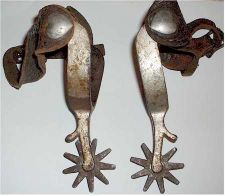
Western-style cowboy spurs with rowels,
chap guards and buttons for the spur straps. |

Parts of a simple spur |
The parts of a spur include:
* The yoke, branch, or heel band, which
wraps around the heel of the boot.
* The shank or neck, which extends
from the back of the heel band and is the area that usually touches the
horse
* The rowel, seen on some spurs, a
small revolving wheel or disk with radiating points at the end attached
to the shank. |
| Spurs are usually held on by a leather or leather-like
strap, called a spur strap, that goes over the arch of the foot and under
the sole in front of the boot heel. Some western designs have a leather
strap that goes only over the top, with a heel chain or a rubber "tiedown"
instead of a strap under the boot. There are also styles with no straps
where the heel band simply is very tight and slips on wedged between the
sole and heel of the boot. Some spur designs have a slot for running the
spur strap through, others have "buttons," sometimes on the heel band itself
and sometimes attached to the heel band by hinges, that allow a strap with
buttonholes to be attached.
When used in military ranks, senior officers, and officers
of all ranks in cavalry and other formerly mounted units of some armies,
wear a form of spur in certain orders of dress which is known as the box
spur, having no spur strap but a long metal prong opposite the neck, extending
between the arms of the heel band, which is inserted into a specially fitted
recess or "box" in the base of the boot heel. Due to the prong, such spurs
can only be worn with appropriately equipped boots. This construction is
shown in the illustrations of the swan neck and waterford spurs below. |
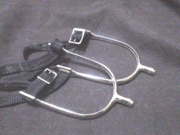
Spur straps on an
English "Prince of Wales" spur |
Spurs seen in western riding may also have small curved-up
hooks on the shank in front of the rowel, called "chap guards," that were
originally used to prevent the rider's chaps from interfering with the
rowels of the spur. Some cowboys also added small metal Pajados, also known
as Jingo Bobs or Jingle Bobs, near the rowel, to create a jingling sound
whenever the foot moved.
In the history of veterinary science, the word "rowel"
described a small disk of leather or other material that was used as a
seton stitch.
History
The spur's use cannot with certainty be traced further
back than Ancient Rome. Early spurs had a neck that ended in a point, called
a prick, riveted to the heel band. Prick spurs had straight necks in the
11th century and bent ones in the 12th. The earliest form of the horseman's
spur armed the heel with a single prick. In England the rowel spur is shown
upon the first seal of Henry III and on monuments of the 13th century,
but it does not come into general use until the 14th century. The earliest
rowels probably did not revolve but were fixed.
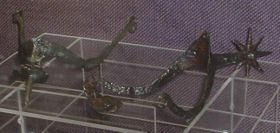
An iron prick-spur (13th-14th century) and an iron
spur with eight-pointed rowel (15th century). |
The spurs of medieval knights were gilt and those of
esquires silvered. "To win his spurs" meant to gain knighthood, as gilded
spurs were reckoned the badge of knighthood. In the rare cases of ceremonious
degradation, they were hacked from the knights heels by the cooks chopper.
After the battle of the Golden Spurs in 1302 where the French chivalry
suffered a humbling defeat, the victors hung up bushels of knights' gilt
spurs in the churches of Kortrijk as trophies of what is still remembered
by the Flemings as the Guldensporenslag (the battle of the golden spurs).
For another reason the English named the French route beside Thérouanne
as the Battle of Spurs.
Prick spurs were the standard form until the 14th century,
when the rowel began to become more common. The prick design never died
out entirely, but instead became a thicker, shorter neck with a dulled
end, such as the modern "Prince of Wales" design commonly seen in English
riding. |
Though often decorated throughout history, in the 15th
century, spurs became an art form in both decoration and design, with elaborate
engraving, very long shanks and large rowels. Though sometimes it has been
claimed that the design changes were used because of barding, the use of
barding had fallen out of fashion by the time the most elaborate spur designs
were created. More likely, the elaborate designs reflected the increased
abundance of precious metals, particularly silver, that followed the European
exploration of the Americas that began in 1492. Spur designs in Spain and
colonial Mexico were particularly elaborate. For example, the spurs of
the Spanish Conquistadors were sometimes called Espuela Grande, the "Grand
Spur," and could have rowels as large as six inches around.[1]
In northern Europe, the spur became less elaborate after
the 16th century, particularly following the Stuart Restoration, but elaborte
spur designs persisted, particularly in the Americas, descendants of which
are still seen today, particularly in Mexico and the western United States,
where the spur has become an integral part of the vaquero and cowboy traditions.
The spur as an art form as well as a tool is still seen in western riding,
where spurs with engraving and other artistic elements, often handmade
and utilizing silver or other precious metals are still worn.
Collecting of particularly beautiful antique spurs is
a popular pastime for some individuals, particularly aficionados of western
history and cowboy culture.
Spurs as modern honours
Just as a medieval knight was said to have "earned his
spurs," analogously, the awarding of spurs has continued in the modern
era as an honour bestowed upon individuals in organisations with military
heritages. Members of the Papal Orders of Chivalry receive gilt spurs directly
from the hands of the Pope; members of the British Order of the Garter
similarly receive gilt spurs from the Monarch. Inductees into the American
Order of the Spur receive yellow-coloured (usually brass) spurs if they
have earned their membership through combat, or silver-coloured (usually
nickel) spurs if they have passed a proficiency test and not seen combat.
Basic designs and wear
Spurs should always be worn with the tip of the neck pointed
downward, sitting on the spur rest of the riding boot, if there is one,
with the buckle of the spur strap worn on the outside of the foot.
Spur styles differ between disciplines. Spurs for western
riding tend to be heavier, often decorated, and have rowels that rotate.
The neck of western spurs is usually longer and the rowel wide in diameter,
to accommodate the leg position of the Western-style rider, where the stirrup
is adjusted long, and the heavy leather used for the saddle's fenders and
stirrups places the rider's leg a bit farther from the horse.
Spurs in English riding tend to use a spur that is very
sleek, slim and conservative in design, with a shorter neck, as the saddle
and leg position is closer to the horse. They usually have a rounded or
blunt end. Rowels are not as popular as the plain blunt end, although there
are types that include a rowel or smooth disk on the end. When used in
sports requiring finesse, such as dressage, the spur's purpose is not to
speed up a horse, but to give accurate and precise aids in lateral and
complex movements, such as pirouettes, travers and renvers, and the airs
above the ground. Dressage riders tend to ride in "Waterford" style spurs
with a rounded knob at the end. Conversely, show hunter and jumper riders
may use a flatter end to encourage forward movement, such as the Prince
of Wales design.
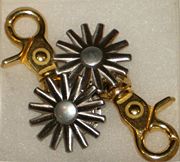
Motorcycle Spurs from
Loop Spurs |
Modern types of spurs also includes motorcycle spurs.
They are basically rowels worn as foot jewelry, hung off of boots. They
can be similar in appearance to spurs worn by equestrians. Some designs
may improve motorcycle safety, when their bright material attracts motor
vehicle drivers to the presence of motorcyclists, especially to their feet
where riders are most vulnerable when stopped in traffic. Their owners
will further customize them by adding miniature strobing LED lights, or
rare-earth magnets that activate traffic lights. |
|
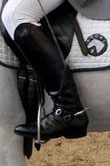
English riding spur |
Technique
The spur is a refined tool, designed to allow the rider
to transmit very subtle signals to the horse that are nearly invisible
to any other observer. No matter the discipline, it is important that a
rider has a correct position before using spurs, with a deep seat, legs
lengthened to the extent allowed by the stirrups, heels down, with knees
and thighs rolled in so that the rider has a solid base of support. A swinging
or unstable leg may inadvertently jab the horse with the spur as the rider
sits, thus irritating, distracting, or frightening the animal, and chronic
misuse may deaden the horse to the leg aids. Improper use may also provoke
dangerous or undesirable behaviors such as bucking or running away.
Spurs are rarely used in sports such as horse racing,
where the rider's leg is not significantly in contact with the horse.
Most spurs are activated by the rider flexing the heel
slightly up and in. A roweled spur permits an additional type of action;
a rider can roll the spur lightly against the side of the horse rather
than being limited to simply pressing inward.
Rodeo spurring
The exception to the use of spurs in a subtle fashion
is in the rodeo events of bull riding, Saddle Bronc and Bareback Riding,
where the rider is required to spur in an elaborate, stylized fashion,
touching the horse or bull at every stride. This requirement is designed
to resemble the behavior of old-time horse-breakers who would deliberately
provoke a horse to buck. In modern times, riders are required to use spurs
in a manner that is merely encouraging an animal that is already predisposed
to buck; they are not to produce pain. Spur design and use is strictly
defined by rodeo rules, spurs are dull and rowels must turn freely. In
fact, the way spurs are to be used in bucking events generally makes it
harder for the rider to stay on: in bareback bronc competition, the spurs
must be above the point of the horse's shoulder at the first jump and remain
forward at all times, deliberately creating a very awkward position for
the rider that requires both strength and coordination to stay on the horse.
In saddle bronc competition, the rider must make a full sweep with the
spurs from shoulder to flank with each jump, requiring great concentration
and any error in balance putting the rider in a position to be quickly
unseated. Bull riders are allowed a position that is the closest to that
of classic equestrianism, they are not required to spur the bull, but if
they choose to spur, may do so with their legs down in a style that approaches
a normal riding position.
Types of spurs
| Spurs are divided into Men's, Women's, and Children's,
according to width (which must fit on the heel of the rider's boot). Spurs
are further divided into length of the neck, with 1/4" being relatively
small (and a common size in children's spurs), with some being 2-3" long.
Many competition rules limit the length of the neck.
* Round end: end is a metal ball about
the size of a small marble, making it one of the milder spurs
* Knob end: end of the spur is squared
off but blunted at the edges
* Prince of Wales: has a flat end,
making is slightly sharper. This is a popular spur.
* Rowelled spur: the end of the spur
has a toothed wheel which spins. This is the most common western-style
spur, although it is seen on some English-style spurs. Teeth are dulled
at the points. A rowel with many small teeth is milder than one with only
a few, larger teeth. Most rowels have at least eight teeth on each wheel.
Other variations, more common in English riding, include:
o Disc: the end has a small rowel-like rolling disc without teeth, which
allows the spur to roll on the horse's side when applied, decreasing chance
of spur marks. Popular in dressage. Severity depends on thickness of disc.
o Roller spur: end of the neck has a plastic "roller," which moves as the
horse's side is touched. This spur tends to reduce spur-rubs on sensitive
horses. It is considered very mild.
* Swan-neck: the neck of the spur
goes upward at an angle, before leveling off, looking similar to the neck
of a swan. This is commonly seen in dressage.
* Waterford: the end of the neck has
a large, round metal ball, making the spur softer and less likely to cause
spur rubs.
* Le spur (English) or Barrel Racing
Spur (Western): a spur with small "teeth" or ridges on the inside of the
heel band, instead of a neck. For use, the rider does not have to turn
in the heel. A quicker and more subtle design, but also more apt to be
accidentally used when not intended.
================================================================================ |

Prince of Wales |

Disk |

Swan neck, rowels |

Waterford spur |
|
|